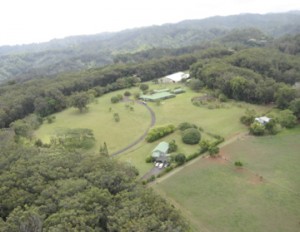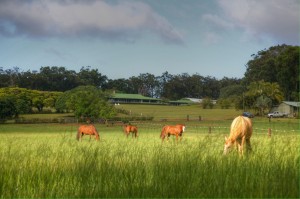Legacy Land Conservation Fund
As Hawaii residents are well aware, many of the State’s natural, cultural and agricultural resources are lost when certain lands are sold and developed. A “Land Conservation Fund” was established by the State of Hawaii in 1973 for the purpose of funding the protection of such lands. Unfortunately, the fund sat dormant until 2005 when the Hawaii State Legislature passed the Legacy Lands Act, and Governor Linda Lingle signed it into law. The Legacy Land Act legislation had two notable elements that enabled the State to thoughtfully and systematically fund land conservation projects in Hawaii:
The Legacy Land Act created a nine-member commission, the Legacy Land Conservation Commission (“LLCC”), composed of natural, cultural and agricultural resource experts representing each county in the State of Hawaii. The LLCC reviews every project submitted for funding and advises the State’s Board of Land and Natural Resources on annual project selections. The projects are then subject to additional levels of review before they finally make their way to the Governor for the final decision on project funding.
(ii) 10% of Conveyance Taxes
Perhaps most importantly, the Legacy Land Act created a dedicated funding source for the newly named Legacy Land Conservation Fund (“LLCF”) by allocating 10% of all State conveyance taxes (taxes imposed on the transfer of all commercial and residential real estate) to land conservation projects in Hawaii. The law explicitly states that the LLCF be used “for the acquisition of interests of rights in land having value as a resource to the State for the preservation of agricultural lands, among other conservation purposes”. Funds can be used to acquire land at fair market value, or for conservation easements, including but not limited to projects with the following characteristics: (i) watershed protection, (ii) parks, (iii) coastal areas, (iv) habitat protection, (v) agricultural sites, (vi) culturally significant sites, and (vii) open space. The LLCF awards grants to counties, local organizations and other agencies. Grant recipients are required to provide matching funds of at least 25% of total project costs.
Sunset Ranch was blessed to have been recommended and approved for funding by the LLCF in 2009. The project was also fortunate to recieve federal and county funding. Federal funding came from the Natural Resource Conservation Service (“NRCS”), a division of the United States Department of Agricultural (“USDA”); City and County of Honolulu funding came from the Clean Water and Natural Lands Fund (“CWNLF”)(we will be blogging about the CWNLF in the near future). The USDA contributed 50% to the project; the LLCF, 25%; and the CWNLF, 25%. The importance of financial leverage to land conservation projects cannot be overstated. In the case of Sunset Ranch, the LLCF committed 25% of what otherwise would’ve been required without the financial leverage provided by the federal and county programs.
Private conservation easements reduce land conservation project costs to state and local agencies even further. How? With a private conservation easement, the agency is no longer buying a fee simple interest in the fair market value of the land. Instead, the agency is purchasing a conservation easement that legally enforces the landowner to never subdivide. Said differenlty, the development rights of the property are stripped away in exchange for payment. Generally speaking, the value of a conservation easement (development rights) is typically between 40% to 50% of the value of a fee simple interest in the land. The obvious result here is that the agency is able to accomplish the objective of land conservation at a fraction of the price. Further, the responsiblilties of ongoing maintenance, management and liability remain with the land owner, and the property remains a revenue source to the county as the landowner is still required to pay property taxes.
Factoring the benefits of financial leverage together with the structure of a private conservation easement, the LLCF committed approximately 10% of what it otherwise would’ve had to commit to protect Sunset Ranch. This calculation does not consider the ongoing costs required to manage and maintain the property. This is why it is so important for Hawaii residents to be aware of these programs. Especially during these times when our state and county governments have limited financial resources.
Sunset Ranch remains focused on its mission of helping advance land conservation in Hawaii through: (i) events, (ii) farming, (iii) a nursery, and (iv) horsemanship. Among other things, we believe these efforts will allow us to establish Sunset Ranch as a platform to effectively educate landowners, the local community and visitors on the importance of federal, state and county land conservation programs. Please contact us with any questions regarding the Legacy Land Conservation Fund. You can also learn more about the application and award selection process for the LLCF here.
LLCF Project Awards: 2010
In 2010, the Legacy Land Conservation Fund conveyed over $3 million for land conservation projects in Hawaii. These funds were matched with approximately $9.5 million in federal, county and private funds, and used to acquire and protect approximately 752 acres of threatened or unique natural, cultural, recreational, and agricultural resources. The following is a brief summary of the projects protected in 2010, as communicated by the LLCC:
1. County of Hawaii and the Trust for Public Land: $945,000 for the acquisition of approximately 10.61 acres on the Island of Hawaii, coastline lot within Paoo ahupuaa, North Kohala District, to protect over 27 cultural sites from development and maintain the natural landscape and scenic views of the Kohala coastline.
2. Department of Land and Natural Resources, Division of Forestry & Wildlife: $500,000 for the acquisition of a conservation easement over approximately 614 acres on the Island of Molokai to protect critical watershed and prevent erosion damage to near-shore coral reef ecosystems and historic Hawaiian fishponds.
3. Kauai Public Land Trust and the County of Kauai: $800,000 for the acquisition of approximately 0.74 acre on the Island of Kauai, on Hanalei Bay, to be held by the County of Kauai, to enhance and protect the heavily used Black Pot Beach Park area for Hawaii’s residents and visitors.
4. Kona Historical Society: $255,592 for the acquisition of approximately 2.11 acres on the Island of Hawaii, South Kona, to provide a scenic buffer for the historic H.N. Greenwell Store and additional space for preservation of the farming and ranching heritage of Kona.
5. The Trust for Public Land and Oahu Land Trust: $500,000 for the acquisition of a conservation easement over approximately 107.73 acres on the Island of Oahu, ahupua‘a of Kaalaea, in the Koolaupoko District, to be held by the Oahu Land Trust, to protect agricultural production and maintain a portion of the rural character of windward Oahu.
6. Malu Aina Center for Non-Violent Education and Action and the Hawaii Island Land Trust (HILT): $231,788 for the acquisition of approximately 11.14 acres on the Island of Hawaii, Puna District; with a conservation easement to be held by HILT, to maintain agricultural production on lands with kipuka deep soil and abundant rainfall.
7. HILT: $35,000 for the acquisition of conservation easements over approximately 6 acres on the Island of Hawaii, Puna District; to preserve an intact native ohia forest canopy that allows native birds, insects and plants to travel and propagate.
LLCF Project Awards: 2009
In 2009, the Legacy Land Conservation Fund conveyed over $3 million for land conservation projects in Hawaii. The State funds leveraged approximately $6.6 million in matching federal funds and $1.5 million in private and county funds towards the protection of land. The following is a brief summary of the projects funded in 2009 as communicated by the LLCC:
1. State of Hawaii: $982,956.50 for the acquisition of approximately 3,582 acres in Honouliuli Preserve, Waianae Mountain Range, Island of Oahu, for its natural habitat, watershed, and recreational values;
2. State of Hawaii: $450,000 for the acquisition of approximately 65.56 acres in Hamakua, Kailua, Island of Oahu, for its natural habitat, watershed, scenic, and open space values;
3. State of Hawaii: $7,000 for the acquisition of approximately 7 acres in North Kohala, Island of Hawaii, for its cultural, historic, and scenic values;
4. State of Hawaii: $1,250,000 for the acquisition of approximately 17.05 acres in Lapakahi, Kohala, Island of Hawaii, for its coastal, cultural, and natural values; and
5. Maui Coastal Land Trust: $609,425 for the acquisition of an agricultural conservation easement over approximately 27.44 acres, in Pupukea, North Shore, Island of Oahu, to be held by the North Shore Community Land Trust, for its agricultural and open space values.



No Comments